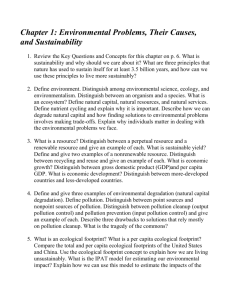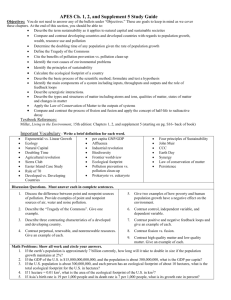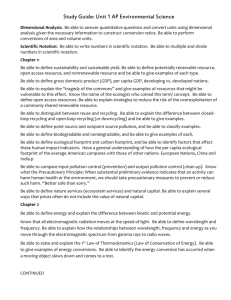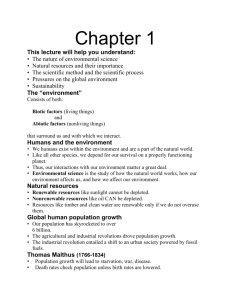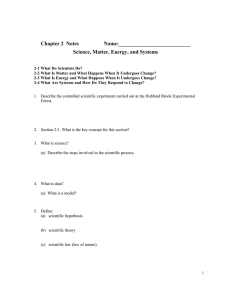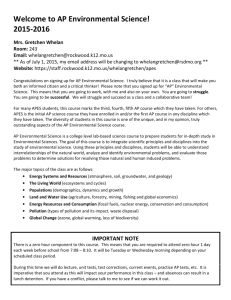UNIT 1_Chapters 1and2 Study Guide _1_
advertisement
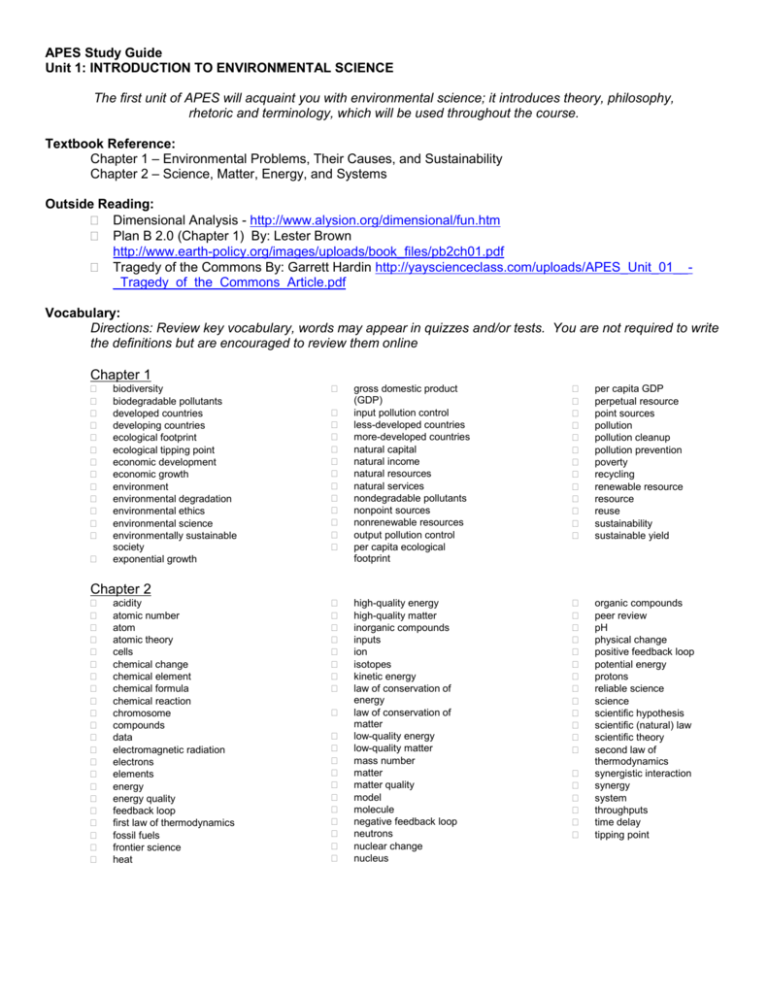
APES Study Guide Unit 1: INTRODUCTION TO ENVIRONMENTAL SCIENCE The first unit of APES will acquaint you with environmental science; it introduces theory, philosophy, rhetoric and terminology, which will be used throughout the course. Textbook Reference: Chapter 1 – Environmental Problems, Their Causes, and Sustainability Chapter 2 – Science, Matter, Energy, and Systems Outside Reading: Dimensional Analysis - http://www.alysion.org/dimensional/fun.htm Plan B 2.0 (Chapter 1) By: Lester Brown http://www.earth-policy.org/images/uploads/book_files/pb2ch01.pdf Tragedy of the Commons By: Garrett Hardin http://yayscienceclass.com/uploads/APES_Unit_01___Tragedy_of_the_Commons_Article.pdf Vocabulary: Directions: Review key vocabulary, words may appear in quizzes and/or tests. You are not required to write the definitions but are encouraged to review them online Chapter 1 biodiversity biodegradable pollutants developed countries developing countries ecological footprint ecological tipping point economic development economic growth environment environmental degradation environmental ethics environmental science environmentally sustainable society exponential growth Chapter 2 acidity atomic number atom atomic theory cells chemical change chemical element chemical formula chemical reaction chromosome compounds data electromagnetic radiation electrons elements energy energy quality feedback loop first law of thermodynamics fossil fuels frontier science heat gross domestic product (GDP) input pollution control less-developed countries more-developed countries natural capital natural income natural resources natural services nondegradable pollutants nonpoint sources nonrenewable resources output pollution control per capita ecological footprint per capita GDP perpetual resource point sources pollution pollution cleanup pollution prevention poverty recycling renewable resource resource reuse sustainability sustainable yield high-quality energy high-quality matter inorganic compounds inputs ion isotopes kinetic energy law of conservation of energy law of conservation of matter low-quality energy low-quality matter mass number matter matter quality model molecule negative feedback loop neutrons nuclear change nucleus organic compounds peer review pH physical change positive feedback loop potential energy protons reliable science science scientific hypothesis scientific (natural) law scientific theory second law of thermodynamics synergistic interaction synergy system throughputs time delay tipping point Study Guide Questions (SGQ): Directions: Answer in complete sentences in your composition books. (must be handwritten) Chapter 1 1. What is sustainability and why should we care about it? 2. What are the three principles that nature has used to sustain itself for 3.5 billion years, and how can we use these principles to live more sustainably? 3. Describe how we can degrade natural capital and how finding solutions to environmental problems involves making trade-offs. Explain why individuals matter in dealing with the environmental problems we face. 4. Distinguish between more-developed countries and less-developed countries and give an example of a high-income, a middle income and a low-income country. 5. Define and give three examples of environmental degradation (natural capital degradation). 6. What is the tragedy of the commons? 7. Compare the total and per capita ecological footprint s of the United States and China. 8. Use the ecological footprint concept to explain how we are living unsustainably. 9. What is the IPAT model for estimating our environmental impact? 10. Explain how we can use this model (IPAT) to estimate the impacts of the human populations in lessdeveloped countries and more developed countries. 11. Describe three major cultural changes that have occurred since humans were hunter-gatherers. 12. Identify four basic causes of the environmental problems that we face today. 13. Describe the past, current, and projected exponential growth of the world’s human population. 14. What is poverty and what are three of its harmful environmental and health effects? 15. Describe the connection between poverty and population growth. Chapter 2 1. Describe the steps involved in the scientific process. 2. Explain why scientific theories are not to be taken lightly and why people often use the term “theory” incorrectly. 3. Describe how a hypothesis about the decline of a civilization on Easter Island has been challenged by new data. 4. What is matter? Distinguish between high- quality matter and low- quality matter and give an example of each. 5. Distinguish between a physical change and a chemical change (chemical reaction) and give an example of each. 6. What is a nuclear change? 7. What is energy? Distinguish between kinetic energy and potential energy and give an example of each. 8. What are fossil fuels and what three fossil fuels do we use most to supplement energy from the sun? 9. What is energy quality? Distinguish between high- quality energy and low- quality energy and give an example of each. 10. What is the first law of thermodynamics (law of conservation of energy) and why is it important? 11. What is the second law of thermodynamics and why is it important? Explain why the second law means that we can never recycle or reuse high- quality energy. 12. Define and give an example of a system 13. What is a feedback loop? Distinguish between a positive feedback loop and a negative (corrective) feedback loop in a system, and give an example of each. Case Studies: Directions: For each of the following reading answer the following: a) What is the author's main idea? Support with two specific examples. b) Summarize the case study in three sentences. c) What ecological lesson can we learn from the case study? d) What is your opinion? Do you agree or disagree? Chapter 1 1. A Vision of a More Sustainable World in 2060 – page 5 2. China’s New Affluent Consumers – page 18 Chapter 2 1. How Do Scientists Learn About Nature? A Story about a Forest – page 31 2. Easter Island: Some Revisions in a Popular Environmental Story – page 35
